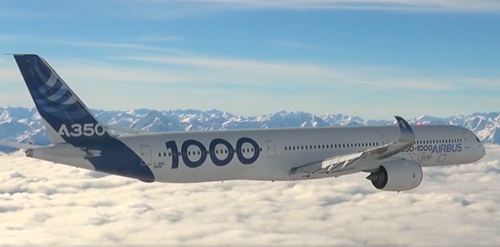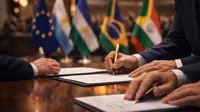United Technologies Corp on Sunday announced a merger of its aerospace business with US defence contractor Raytheon Co, in a move that would create a new company worth about $121 billion.
“Raytheon Company and United Technologies Corp have entered into an agreement to combine in an all-stock merger of equals. The transaction will create a premier systems provider with advanced technologies to address rapidly growing segments within aerospace and defence, United Technologies stated in a release.
The proposed merger of equals, touted as the biggest-ever in the sector, would reshape competition in the sector, including in civil and defence aviation and defence procurement.
“The combined company, which will be named Raytheon Technologies Corporation, will offer expanded technology and R&D capabilities to deliver innovative and cost-effective solutions aligned with customer priorities and the national defence strategies of the US and its allies and friends.”
The merger will bring together Collins Aerospace and Pratt & Whitney to offer a complementary portfolio of platform-agnostic aerospace and defence technologies. The combination, however, excludes Otis and Carrier, which are expected to be separated from United Technologies in the first half of 2020 as previously announced.
United Technologies provides primarily commercial plane makers with electronics, communications and other equipment, whereas Raytheon mainly supplies the US government with military aircraft and missile equipment.
The combined company will have approximately $74 billion in pro forma 2019 sales. With a strong balance sheet and robust cash generation, Raytheon Technologies will enjoy enhanced resources and financial flexibility to support significant R&D and capital investment through business cycles.
The merger will bring significant near- and long-term benefits expected from uniting complementary portfolios of platform-agnostic capabilities, resulting in more than $1 billion of gross annual cost synergies by year four, as well as new revenue opportunities from combined technology.
Return of capital to shareowners is expected to be $18 to $20 billion in first 36 months following completion of the merger.
United Technologies’ separation into three independent companies remains on track; merger is expected to be tax-free and close in the first half of 2020, following completion of UTC portfolio separation.
Under the terms of the agreement, which was unanimously approved by the boards of directors of both companies, Raytheon shareowners will receive 2.3348 shares in the combined company for each Raytheon share. Upon completion of the merger, United Technologies shareowners will own approximately 57 per cent and Raytheon shareowners will own approximately 43 per cent of the combined company on a fully diluted basis.
The merger is expected to close in the first half of 2020, following completion by United Technologies of the previously announced separation of its Otis and Carrier businesses. The timing of the separation of Otis and Carrier is not expected to be affected by the proposed merger and remains on track for completion in the first half of 2020. The merger is intended to qualify as a tax-free reorganization for US federal income tax purposes.
“Today is an exciting and transformational day for our companies, and one that brings with it tremendous opportunity for our future success. Raytheon Technologies will continue a legacy of innovation with an expanded aerospace and defense portfolio supported by the world’s most dedicated workforce,” said Tom Kennedy, Raytheon Chairman and CEO. “With our enhanced capabilities, we will deliver value to our customers by anticipating and addressing their most complex challenges, while delivering significant value to shareowners.”
“The combination of United Technologies and Raytheon will define the future of aerospace and defense,” said Greg Hayes, United Technologies Chairman and CEO. “Our two companies have iconic brands that share a long history of innovation, customer focus and proven execution. By joining forces, we will have unsurpassed technology and expanded R&D capabilities that will allow us to invest through business cycles and address our customers’ highest priorities. Merging our portfolios will also deliver cost and revenue synergies that will create long-term value for our customers and shareowners.”
With a combined annual company and customer funded R&D spend of approximately $8 billion, seven technology centers of excellence, and over 60,000 engineers, the company hopes tofast-track development of new, critical technologies.
Areas of joint advancement include, among others:
- Hypersonics and future missile systems;
- Directed energy weapons;
- Intelligence, surveillance, and reconnaissance (ISR) in contested environments;
- Cyber protection for connected aircraft;
- Next generation connected airspace; and
- Advanced analytics and artificial intelligence for commercial aviation.
Raytheon plans to consolidate its four businesses into two businesses to be named Intelligence, Space & Airborne Systems and Integrated Defence & Missile Systems. The new businesses will join Collins Aerospace and Pratt & Whitney to form the four businesses of Raytheon Technologies.
Net debt for the combined company at the time of closing is expected to be approximately $26 billion, with United Technologies expected to contribute approximately $24 billion. The combined company targets an ‘A’ category credit rating at the time of the closing.
The combined company’s board of directors will have 15 members, consisting of 8 directors from United Technologies and 7 from Raytheon, with the lead director from Raytheon. Tom Kennedy will be appointed executive chairman and Greg Hayes will be named CEO of Raytheon Technologies. Two years following the close of the transaction, Hayes will assume the role of chairman and CEO.
Raytheon Technologies will be headquartered in the greater Boston metro area, and will retain a corporate presence in existing locations. The company will be led by a highly experienced, proven leadership team with a strong track record of innovation, delivering on synergies, and meeting financial and customer commitments.
The transaction is subject to the satisfaction of customary closing conditions, including receipt of required regulatory approvals, the approval of Raytheon and United Technologies shareowners, as well as completion by United Technologies of the separation of its Otis and Carrier businesses. As previously mentioned, the transaction is expected to close in the first half of 2020.






















